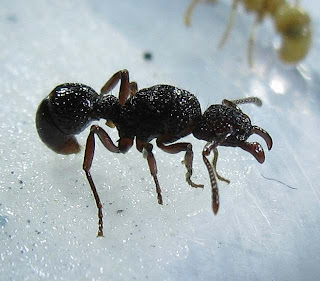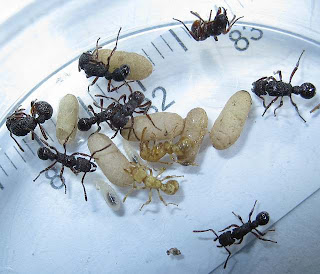Here is a Camponotus species that jumps, not high just around half an inch. Camponotus maculatus pallidus has five morphological expressions in the worker's caste. There two major worker caste, one median and two minor. This species is of the Camponotus arrogans type of Camponotus.
This species is very similar to Camponotus variegatus and is either probably a synonym or variant (species group).
This species is very similar to Camponotus variegatus and is either probably a synonym or variant (species group).
The smallest worker is far left while the largest is far right, the larger minor workers (center), median workers (top left), smaller major workers (top right)
The major worker of a Camponotus maculatus pallidus.
The major worker of a Camponotus maculatus pallidus.
The major worker of a Camponotus maculatus pallidus.
The minor worker of Camponotus maculatus pallidus.
The minor worker od Camponotus maculatus pallidus.
Top view of the major worker of Camponotus maculatus pallidus.
Size comparison between the two morphological expression of Camponotus maculatus pallidus.
Shield bugs protected and milked by Camponotus maculatus.
Last Updated: 2019 04 05
First Posted: 2011 07 27
Shield bugs protected and milked by Camponotus maculatus.
See also:
Camponotus genus
Camponotus bedoti
Camponotus parius
Camponotus gigas
Camponotus gilviceps
Camponotus sp (colobopsis group)
Camponotus sp(10)
Camponotus suandersi (Colobopsis group)
Camponotus genus
Camponotus bedoti
Camponotus parius
Camponotus gigas
Camponotus gilviceps
Camponotus sp (colobopsis group)
Camponotus sp(10)
Camponotus suandersi (Colobopsis group)
Taxonomy:
Top Node: cellular organisms 131567
SuperKingdom: Eukaryota 2759
No Rank: Opisthokonta 33154
Kingdom: Metazoa 33208
No Rank: Eumetazoa 6072
No Rank: Bilateria 33213
No Rank: Coelomata 33316
No Rank: Protostomia 33317
No Rank: Panarthropoda 88770
No Rank: Pancrustacea 197562
Phylum: Arthropoda 6656
No Rank: Mandibulata 197563No Rank: Pancrustacea 197562
Superclass: Hexapoda 6960
Class: Insecta 50557
No Rank: Dicondylia 85512
No Rank: Pterygota 7496
Subclass: Neoptera 33340
Infraclass: Endopterygota 33392
Order: Hymenoptera 7399
No Rank: Apocrita 7400
Suborder: Aculeata 7434
Superfamily: Vespoidea 34725
Family: Formicidae 36668
Subfamily: Formicinae 7479
Tribe: Camponotini 72773
Genus: Camponotus 13390
Species: maculatus pallidus
Subfamily: Formicinae 7479
Tribe: Camponotini 72773
Genus: Camponotus 13390
Species: maculatus pallidus
Last Updated: 2019 04 05
First Posted: 2011 07 27
© 2011 – 2019 Quah. All rights reserved.









































